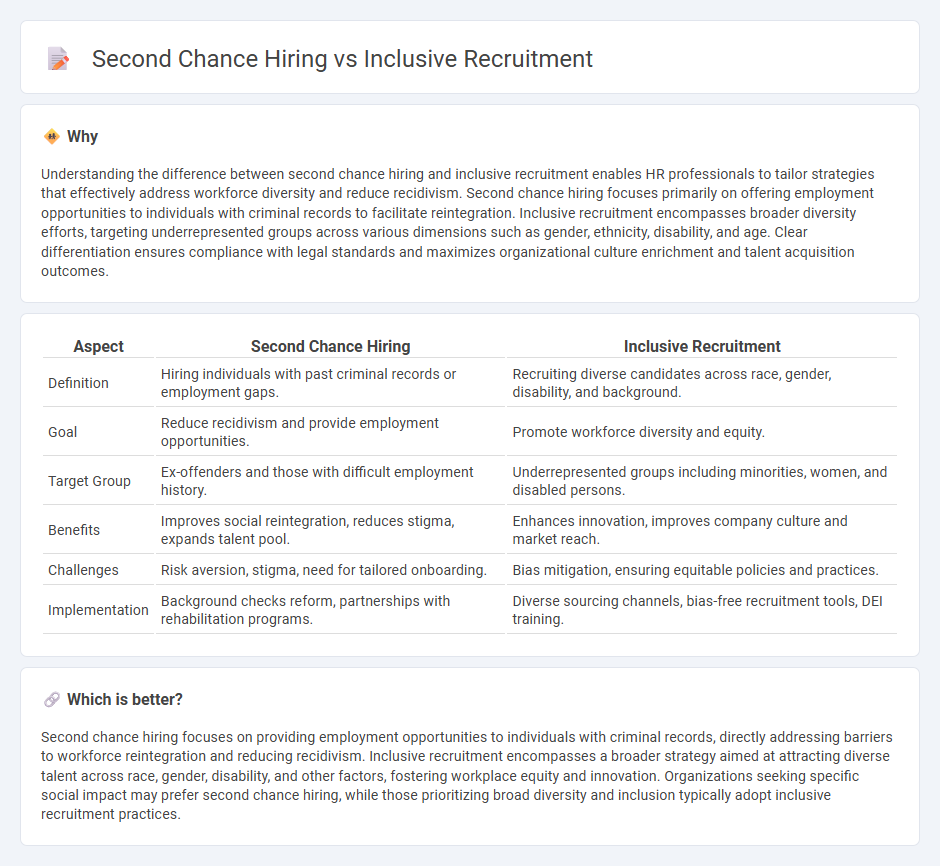
Second chance hiring focuses on offering employment opportunities to individuals with criminal records, promoting workforce reintegration and reducing recidivism, while inclusive recruitment aims to create diverse workplaces by actively seeking candidates from various underrepresented groups. Both strategies contribute to social equity and talent acquisition, though they target different barriers to employment. Explore how integrating these approaches can enhance organizational culture and performance.
Why it is important
Understanding the difference between second chance hiring and inclusive recruitment enables HR professionals to tailor strategies that effectively address workforce diversity and reduce recidivism. Second chance hiring focuses primarily on offering employment opportunities to individuals with criminal records to facilitate reintegration. Inclusive recruitment encompasses broader diversity efforts, targeting underrepresented groups across various dimensions such as gender, ethnicity, disability, and age. Clear differentiation ensures compliance with legal standards and maximizes organizational culture enrichment and talent acquisition outcomes.
Comparison Table
| Aspect | Second Chance Hiring | Inclusive Recruitment |
|---|---|---|
| Definition | Hiring individuals with past criminal records or employment gaps. | Recruiting diverse candidates across race, gender, disability, and background. |
| Goal | Reduce recidivism and provide employment opportunities. | Promote workforce diversity and equity. |
| Target Group | Ex-offenders and those with difficult employment history. | Underrepresented groups including minorities, women, and disabled persons. |
| Benefits | Improves social reintegration, reduces stigma, expands talent pool. | Enhances innovation, improves company culture and market reach. |
| Challenges | Risk aversion, stigma, need for tailored onboarding. | Bias mitigation, ensuring equitable policies and practices. |
| Implementation | Background checks reform, partnerships with rehabilitation programs. | Diverse sourcing channels, bias-free recruitment tools, DEI training. |
Which is better?
Second chance hiring focuses on providing employment opportunities to individuals with criminal records, directly addressing barriers to workforce reintegration and reducing recidivism. Inclusive recruitment encompasses a broader strategy aimed at attracting diverse talent across race, gender, disability, and other factors, fostering workplace equity and innovation. Organizations seeking specific social impact may prefer second chance hiring, while those prioritizing broad diversity and inclusion typically adopt inclusive recruitment practices.
Connection
Second chance hiring and inclusive recruitment both prioritize expanding workforce diversity by providing employment opportunities to individuals with barriers to traditional hiring, such as criminal records or gaps in employment. Inclusive recruitment strategies incorporate second chance hiring to reduce bias and promote equal access, enhancing organizational culture and fostering innovation. These practices improve talent acquisition by valuing diverse experiences and supporting social equity in human resources.
Key Terms
**Inclusive Recruitment:**
Inclusive recruitment emphasizes creating diverse talent pipelines by actively removing biases and barriers in hiring processes to ensure equal opportunities for underrepresented groups. This approach integrates strategies such as blind resume reviews, diverse interview panels, and accessibility accommodations to foster an equitable workplace culture. Discover how inclusive recruitment drives innovation and business performance by exploring best practices and case studies.
Diversity Sourcing
Inclusive recruitment prioritizes diverse talent acquisition by actively removing barriers and biases to create equal opportunities for all candidates, fostering a broad and varied workforce. Second chance hiring specifically targets individuals with criminal records, aiming to reduce recidivism and enhance social equity through employment opportunities. Explore how combining these strategies can strengthen diversity sourcing and promote a more inclusive workplace culture.
Unconscious Bias Mitigation
Unconscious bias mitigation plays a critical role in both inclusive recruitment and second chance hiring by ensuring fair candidate evaluation and reducing discriminatory tendencies during the hiring process. Inclusive recruitment aims to create a diverse workforce by addressing systemic biases across gender, race, and abilities, while second chance hiring focuses specifically on giving employment opportunities to individuals with criminal records, challenging the stigma associated with their background. Explore effective strategies and tools for unconscious bias mitigation to enhance your organization's hiring practices and promote equitable workforce diversity.
Source and External Links
Importance of Diversity and Inclusion Strategies in Recruitment - Inclusive recruitment actively seeks and values candidates from diverse backgrounds through practices like diversity training, accessible websites, and posting jobs on varied platforms to reduce bias and improve inclusivity.
What is inclusive recruitment and why is it important? - RoleMapper - Inclusive recruitment involves designing jobs and hiring processes fairly to remove unnecessary barriers and unconscious bias, attracting a broader talent pool and creating equitable hiring opportunities.
Embracing inclusive recruitment - CII Group - Inclusive recruitment ensures fair and equal opportunities for all candidates by reviewing recruitment procedures and adapting roles such as offering flexible hours or job shares to widen the talent pipeline and support organizational success.
 dowidth.com
dowidth.com